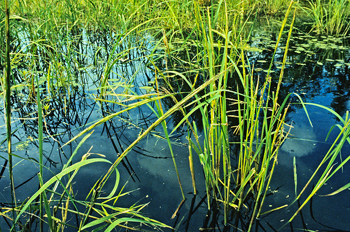
In Minnesota, wild rice is much more than a tasty holiday side dish or main ingredient in soups. The grain, which naturally grows in the state’s lakes, rivers, and wetlands, is of immense importance to many Minnesotans, including the American Indians who harvest and sell it, eat it as a primary food source, and include the rice in significant cultural practices. Wild rice is also an important food for waterfowl.
Research in the 1940s and 1950s found that wild rice grows best in low-sulfate lakes, but scientists couldn’t figure out exactly why. Sulfate was of concern because wastewater from various industries often contains a lot of sulfate, which could then makes its way into nearby water bodies and threaten the rice. To prevent that, in 1973 the Minnesota Pollution Control Agency set a limit for discharge water sulfate levels to protect wild rice and the wellbeing of the people and wildlife that eat it.
Despite the state’s efforts, there’s evidence that the current sulfate limit doesn’t protect wild rice as expected.
“Today, there are some lakes where sulfate is way above the current standard, and the wild rice is growing just fine, and then there are some lakes where the sulfate is way below that level and wild rice is struggling,” says School of Public Health lecturer and statistician Marta Shore. “This means that sulfate levels aren’t directly affecting wild rice — something additional is going on.”
To find out what, a team of researchers that included Shore took a closer look at the relationship between water bodies, sulfate, and wild rice growth. The results of their research were recently announced in three papers concurrently published in the Journal of Geophysical Research-Biogeosciences (study 1, study 2, and study 3).
“The studies found that wild rice is negatively affected if sulfide is elevated in the soil where it germinates each spring,” says Shore.
The sulfide comes from sulfate in the water that makes its way into the soil in which wild rice is rooted. More specifically, sulfide is created when bacteria use carbon found in the soil in a process that transforms sulfate into sulfide. How much sulfide is produced depends on how much carbon is present. Generally speaking, the more carbon in the soil, the more bacteria will use it to turn sulfate into sulfide.
“However, we also found that if iron was also in the soil, it precipitated the sulfide, which makes it non-toxic to wild rice,” says Shore. “So, the research shows that the rice can be affected by sulfate if it turns into sulfide, but other conditions need to be present as well.”
Put it all together, and the researchers figured out that the safe levels of sulfate in a body of water are better determined by measuring how much carbon is available to make sulfide and the amount of iron present to neutralize it.
The research is now being used by the Minnesota Pollution Control Agency (MPCA) to precisely calculate safe sulfate levels for each lake, stream, or wetland that supports wild rice.
“The MPCA used our description of how the process works to create a formula — instead of a fixed standard — for regulating sulfate in discharge water based on the amounts of carbon and iron present in affected lakes,” says Shore. “It’s a really cool, innovative, and new approach.”
According to Shore, the new approach drops the error in regulating the sulfate levels in lakes from more than 30 percent to 16 percent.
“It’s pretty exciting to be part of this project that will go into a policy and standard that will do a much better job at ensuring that we have conditions where wild rice can grow and protect a resource that is so important to Minnesotans,” says Shore.
